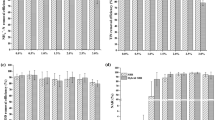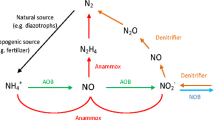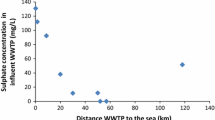Abstract
Domestic wastewater entering the wastewater treatment plant (WWTP) of Kerkennah (Tunisia) contains high organic load and high salinity. The biological treatment of these influents with conventional microorganisms has proven to be not very effective, which might be improved by functionally selected halotolerant/halophilic heterotrophic bacteria. Therefore, a laboratory-scaled activated sludge reactor (ASR) was used for a continuous treatment of this wastewater. The performance of the ASR, inoculated with a mixed culture of active biomass gradually acclimated to the wastewater, was evaluated in terms of carbonaceous pollutant removal efficiency. Experiments were conducted at different organic loading rates (OLRs, varying from 250 to 1200 mg chemical oxygen demand (COD)/l.d). The descriptive analysis showed that the removal efficiency (r) of the ASR was high, peaking at 95% for CODr in medium OLRs, and up to 99% for Biological oxygen demand (BODr) and total suspended solids for high OLRs and salinity. The overall removal efficiency was improved by 1/3th or more compared to the WWTP by these selected and acclimated bacteria. The different observations were combined in an innovative statistical design of Hierarchical clustering. This method improves on traditional approaches by allowing flexibility in understanding the complex variations within the WWTP and the ASR. The identification of the bacterial biomass responsible for high BODr in the ASR by conventional microbiology demonstrated the dominance of Proteus mirabilis and Aeromonas hydrophila. The 16S rRNA gene gave a more accurate identification, indicating a great bacterial diversity and the possibility of a new species.








Similar content being viewed by others
References
Abou-Elela SI, Kamel MM, Fawzy ME (2010) Biological treatment of saline wastewater using a salt-tolerant microorganism. Desalination 250:1–5
Ali A, Naseem F (2012) Frequency distribution of bacteria isolated from different industrial effluents. Daffodil Int Uni J Sci Technol 7:28–33
Alipour V, Moein F, Rezaei L (2017) Determining the salt tolerance threshold for biological treatment of salty wastewater. Health Scope 6:e36425
Aloui F, Khoufi S, Loukil S, Sayadi S (2009) Performances of an activated sludge process for the treatment of fish processing saline wastewater. Desalination 246:389–396
Armbruster CE, Mobley HLT, Pearson MM (2018) Pathogenesis of Proteus mirabilis infection. EcoSal Plus. https://doi.org/10.1128/ecosalplus.ESP-0009-2017
Atlas RM (2010) Handbook of Microbiology media. Taylor and Francis Group, LLC, New York
Bawiec A, Pawęsk K, Jarząb A (2016) Changes in the microbial composition of municipal wastewater treated in biological processes. J Ecol Eng 17:41–46
Boujelben I, Gomariz M, Martínez-García M, Santos F, Peña A, López C, Antón J, Maalej S (2012) Spatial and seasonal prokaryotic community dynamics in ponds of increasing salinity of Sfax solar saltern in Tunisia. Antonie van Leeuwenhoek J Microbiol 101:845–857
Boujelben I, Martínez-García M, Van Pelt J, Maalej S (2014) Diversity of cultivable halophilic archaea and bacteria from superficial hypersaline sediments of Tunisian solar salterns. Antonie van Leeuwenhoek J Microbiol 106:675–692
Boujelben I, Samet Y, Messaoud M, Ben Makhlouf M, Maalej S (2017) Descriptive and multivariate analyses of four Tunisian wastewater treatment plants: a comparison between different treatment processes and their efficiency improvement. J Environ Manag 187:63–70
Boujelben I, Gdoura R, Hammami A (2018) A broad-range PCR technique for the diagnosis of infective endocarditis. Braz J Microbiol 49:534–543
Canler JP, Perret JM, Duchène P, Cotteux E (2011) Aide au diagnostic des stations d’épuration par l’observation microscopique. Quae, France
Caraux G, Pinloche S (2005) PermutMatrix: a graphical environment to arrange gene expression profiles in optimal linear order. Bioinformatics 21:1280–1281
Cieszynska M, Wesolowski M, Bartoszewicz M, Nowacki J (2012) Application of physicochemical data for water-quality assessment of water courses in the Gdansk Municipality (South Baltic coast). Environ Monit Assess 184:2017–2029
Delarras C (2014) Pratique en microbiologie de laboratoire: Recherche de bactéries et de levures-moisissures. Lavoisier, Paris
El Boulani A, Mimouni R, Mannas H, Hamadi F, Chaouqy N (2017) Salmonella in wastewater: identification, antibiotic resistance and the impact on the marine environment. In: Mares M (ed) Current topics in Salmonella and Salmonellosis. IntechOpen, London. https://doi.org/10.5772/67298
Gharsallah N, Khannous L, Souissi N, Nasri M (2002) Biological treatment of saline wastewaters from marine-products processing factories by a fixed-bed reactor. J Chem Technol Biotechnol 77:865–870
Gorlenko VM, Bryantseva IA, Rabold S, Tourova TP, Rubtsova D, Smirnova E, Thiel V, Imhoff JF (2009) Ectothiorhodospira variabilis sp. nov., an alkaliphilic and halophilic purple sulfur bacterium from soda lakes. Int J Syst Evol Microbiol 59:658–664
Harvey RA, Cornelissen CN, Fisher BD (2013) Microbiology Lippincott illustrated review. Lippincott Williams & Wilkins, London
Hedlund BP, Geiselbrecht AD, Bair TJ, Staley JT (1999) Polycyclic aromatic hydrocarbon degradation by a new marine bacterium, Neptunomonas naphthovorans gen. nov., sp. nov. Appl Environ Microbiol 65:251–259
Hoffmann M, Monday SR, Allard MW, Strain EA, Whittaker P, Naum M, McCarthy PJ, Lopez JV, Fischer M, Brown EW (2012) Vibrio caribbeanicus sp. nov., isolated from the marine sponge Scleritoderma cyanea. Int J Syst Evol Microbiol 62:1736–1743
Igbinosa EO, Okoh AI (2010) Vibrio fluvialis: an unusual enteric pathogen of increasing public health concern. Int J Environ Res Public Health 7:3628–3643
Janda JM, Abbott SL (2010) The genus Aeromonas: taxonomy, pathogenicity, and infection. Clin Microbiol Rev 23:35–73
Kargi F, Dinçer AR (1997) Biological treatment of saline wastewater by fed-batch operation. J Chem Tech Biotechnol 69:167–172
Kargi F, Dinçer AR (2000) Use of halophilic bacteria in biological treatment of saline wastewater by fed-batch operation. Water Environ Res 72:170–174
Khannous L, Gharsallah N, Souissi N, Ghorbel B, Msaddak L, Nasri M (2001) Traitement biologique d’un effluent salin par boues activées. Microb Hyg Ali 13:6–13
Khannous L, Souissi N, Ghorbel B, Jarboui R, Kallel M, Nasri M, Gharsallah N (2003) Treatment of saline wastewaters from marine-products processing factories by activated sludge reactor. Environ Technol 24:1261–1268
Kumar S, Tamura K, Nei M (1994) MEGA: Molecular Evolutionary Genetics Analysis software for microcomputers. Comput Appl Biosci 10:189–191
Kushner DJ (1993) Growth and nutrition of halophilic bacteria. In: Vreeland RH, Hochstein L (eds) The biology of halophilic bacteria, 1st edn. CRC Press, Boca Raton, pp 87–103
Larsen H (1962) Halophilism. In: Gunsalus IC, Stanier RY (eds) The bacteria, vol 4. Academic Press, New York, pp 297–342
Le Borgne S, Paniagua D, Vazquez-Duhalt R (2008) Biodegradation of organic pollutants by halophilic bacteria and archaea. J Mol Microbiol Biotechnol 15:74–92
Lefebvre O (2005) Application des micro-organismes halophiles au traitement des effluents industriels hypersalins. Dissertation, University of Montpellier
Lefebvre O, Moletta R (2006) Treatment of organic pollution in industrial saline wastewater: a literature review. Water Res 40:3671–3682
Long S, Prober C, Fischer M (2018) Principles and practice of pediatric infectious diseases. Elsevier, Philadelphia
Ludzack FJ, Noran PK (1965) Tolerance of high salinities by conventional wastewater treatment process. J Water Pollut Control Fed 37:1404–1416
Mansouri S, Pahlavanzadeh F (2009) Hemolysin production, salt tolerance, antibacterial resistance, and prevalence of extended spectrum β-lactamases in Proteus bacilli isolated from clinical and environmental sources. Jundishapur J Microbiol 2:97–104
Matches JR, Liston J (1972) Effects of incubation on the salt tolerance of salmonella Milk. Food Technol 35:39–44
Nagai F, Morotomi M, Sakon H, Tanaka R (2009) Parasutterella excrementihominis gen. nov., sp. nov., a member of the family Alcaligenaceae isolated from human faeces. Int J Syst Evol Microbiol 59:1793–1797
Perrodin Y, Volatier L, Bazin C, Boisson JC (2012) Assessment of ecological risks linked to the discharge of saline effluents into a river. Environ Sci Pollut Res 20:1450–1460
Pianetti A, Manti A, Boi P, Citterio B, Sabatini L, Papa S, Rocchi MB, Bruscolini F (2008) Determination of viability of Aeromonas hydrophila in increasing concentrations of sodium chloride at different temperatures by flow cytometry and plate count technique. Int J Food Microbiol 127:252–260
Renvoisé A (2012) Applicabilité de la PCR « universelle» 16S comme outil d’identification et de détection bactérienne en laboratoire hospitalier de bactériologie. Dissertation, University of Marseille
Salmanikhas N, Tizghadam M, Rashidi Mehrabadi A (2016) Treatment of saline municipal wastewater using hybrid growth system. J Biol Eng 10:1–10
Siala M, Jaulhac B, Gdoura R, Sibilia J, Fourati H, Younes M, Baklouti S, Bargaoui N, Sellami S, Znazen A, Barthel C, Collin E, Hammami A, Sghir A (2008) Analysis of bacterial DNA in synovial tissue of Tunisian patients with reactive and undifferentiated arthritis by broad-range PCR, cloning and sequencing. Arthritis Res Ther 10:1–14
Subhash Y, Tushar L, Sasikala Ch, Ramana ChV (2013) Mongoliicoccus alkaliphilus sp. nov. and Litoribacter alkaliphilus sp. nov., isolated from salt pans. Int J Syst Evol Microbiol 63:3457–3462
Tiquia SM, Davis D, Hadid H, Kasparian S, Ismail M, Sahly R, Shim J, Singh S, Murray KS (2006) Halophilic and halotolerant bacteria from river waters and shallow groundwater along the Rouge River of southeastern Michigan. Environ Technol 28:297–307
Védry B (1987) L’analyse écologique des boues activées à l’usage des exploitants de stations d’épuration. SEGETEC, Paris
Wu L, Lin X, Wang F, Ye D, Xiao X, Wang S, Peng X (2006) OmpW and OmpV are required for NaCl regulation in Photobacterium damsela. J Proteome Res 5:2250–2257
Acknowledgments
This research work has been realized in partnership with the National Sanitation Office (ONAS) (Sfax) and Faculty of Sciences of Sfax (FSS) (Laboratory of Toxicologie—Microbiologie Environnementale et Santé). It is supported by a program funded by the European Union entitled “Support project for scientific research and innovation (PASRI)” as well as “the National Agency for the Promotion of Scientific Research (ANPR)” for the 2017–2019 MOBIDOC grants. The authors would like to express their sincere gratitude to Mrs. Leila Mahfoudhi from the English Language Unit at the Faculty of Science of Sfax, Tunisia, for editing and proofreading the language of the manuscript.
Author information
Authors and Affiliations
Corresponding author
Additional information
Editorial responsibility: Samareh Mirkia.
Electronic supplementary material
Below is the link to the electronic supplementary material.
Rights and permissions
About this article
Cite this article
Boujelben, I., Sabri, S., van Pelt, J. et al. Functional selection of bacteria in an activated sludge reactor for application in saline wastewater treatment in Kerkennah, Tunisia. Int. J. Environ. Sci. Technol. 18, 1561–1578 (2021). https://doi.org/10.1007/s13762-020-02928-1
Received:
Revised:
Accepted:
Published:
Issue Date:
DOI: https://doi.org/10.1007/s13762-020-02928-1




